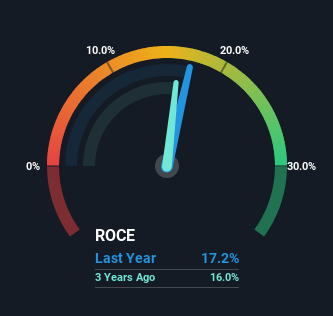- India
- /
- Electrical
- /
- NSEI:CORDSCABLE
Some Investors May Be Worried About Cords Cable Industries' (NSE:CORDSCABLE) Returns On Capital
When we're researching a company, it's sometimes hard to find the warning signs, but there are some financial metrics that can help spot trouble early. Businesses in decline often have two underlying trends, firstly, a declining return on capital employed (ROCE) and a declining base of capital employed. This combination can tell you that not only is the company investing less, it's earning less on what it does invest. On that note, looking into Cords Cable Industries (NSE:CORDSCABLE), we weren't too upbeat about how things were going.
What Is Return On Capital Employed (ROCE)?
Just to clarify if you're unsure, ROCE is a metric for evaluating how much pre-tax income (in percentage terms) a company earns on the capital invested in its business. The formula for this calculation on Cords Cable Industries is:
Return on Capital Employed = Earnings Before Interest and Tax (EBIT) ÷ (Total Assets - Current Liabilities)
0.17 = ₹324m ÷ (₹3.5b - ₹1.6b) (Based on the trailing twelve months to December 2023).
So, Cords Cable Industries has an ROCE of 17%. That's a relatively normal return on capital, and it's around the 18% generated by the Electrical industry.
See our latest analysis for Cords Cable Industries

While the past is not representative of the future, it can be helpful to know how a company has performed historically, which is why we have this chart above. If you're interested in investigating Cords Cable Industries' past further, check out this free graph covering Cords Cable Industries' past earnings, revenue and cash flow.
What Can We Tell From Cords Cable Industries' ROCE Trend?
We are a bit worried about the trend of returns on capital at Cords Cable Industries. To be more specific, the ROCE was 22% five years ago, but since then it has dropped noticeably. On top of that, it's worth noting that the amount of capital employed within the business has remained relatively steady. Since returns are falling and the business has the same amount of assets employed, this can suggest it's a mature business that hasn't had much growth in the last five years. So because these trends aren't typically conducive to creating a multi-bagger, we wouldn't hold our breath on Cords Cable Industries becoming one if things continue as they have.
On a separate but related note, it's important to know that Cords Cable Industries has a current liabilities to total assets ratio of 46%, which we'd consider pretty high. This can bring about some risks because the company is basically operating with a rather large reliance on its suppliers or other sorts of short-term creditors. Ideally we'd like to see this reduce as that would mean fewer obligations bearing risks.
Our Take On Cords Cable Industries' ROCE
In the end, the trend of lower returns on the same amount of capital isn't typically an indication that we're looking at a growth stock. Since the stock has skyrocketed 154% over the last five years, it looks like investors have high expectations of the stock. In any case, the current underlying trends don't bode well for long term performance so unless they reverse, we'd start looking elsewhere.
One final note, you should learn about the 3 warning signs we've spotted with Cords Cable Industries (including 2 which are potentially serious) .
If you want to search for solid companies with great earnings, check out this free list of companies with good balance sheets and impressive returns on equity.
New: AI Stock Screener & Alerts
Our new AI Stock Screener scans the market every day to uncover opportunities.
• Dividend Powerhouses (3%+ Yield)
• Undervalued Small Caps with Insider Buying
• High growth Tech and AI Companies
Or build your own from over 50 metrics.
Have feedback on this article? Concerned about the content? Get in touch with us directly. Alternatively, email editorial-team (at) simplywallst.com.
This article by Simply Wall St is general in nature. We provide commentary based on historical data and analyst forecasts only using an unbiased methodology and our articles are not intended to be financial advice. It does not constitute a recommendation to buy or sell any stock, and does not take account of your objectives, or your financial situation. We aim to bring you long-term focused analysis driven by fundamental data. Note that our analysis may not factor in the latest price-sensitive company announcements or qualitative material. Simply Wall St has no position in any stocks mentioned.
About NSEI:CORDSCABLE
Cords Cable Industries
Engages in the design, development, manufacture, and sale of power, control, instrumentation, thermocouple extension/compensating, and communication cables in India.
Solid track record with low risk.
Similar Companies
Market Insights
Community Narratives




